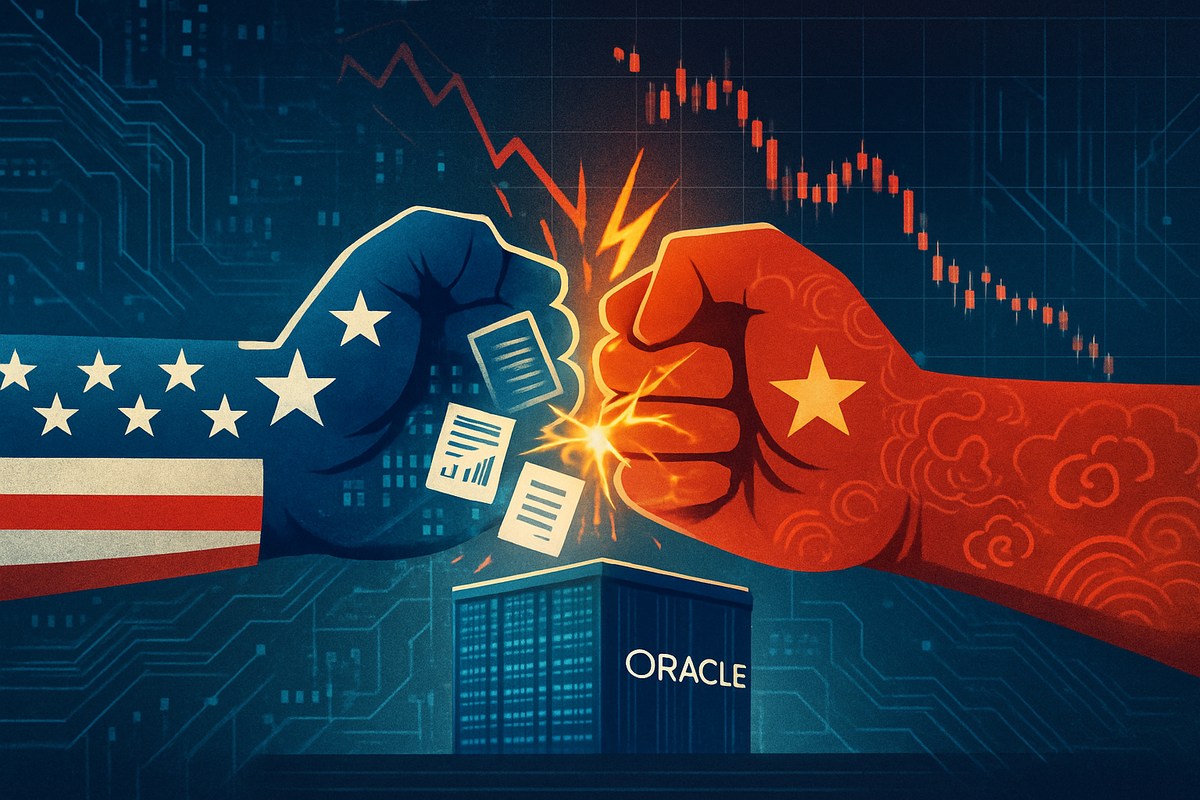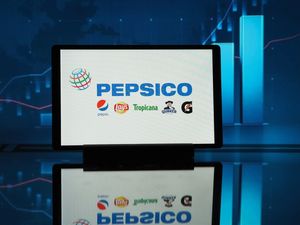
October 10, 2025 – The U.S. stock market experienced a significant downturn today, fueled by a sharp escalation in US-China trade tensions. Former President Donald Trump's threats of "massive" new tariffs on Chinese products, coupled with China's retaliatory measures, sent shockwaves across global markets, triggering a broad sell-off. Amidst this widespread market anxiety, tech giant Oracle (NYSE: ORCL) displayed a mixed performance, initially showing resilience before succumbing to the broader negative sentiment.
The immediate implications for the market were clear: a rapid increase in volatility and a pronounced "risk-off" environment. Investors, wary of a renewed trade war, sought safe-haven assets, while equities, particularly in the technology and manufacturing sectors, faced substantial pressure. This renewed geopolitical friction threatens to undermine global growth prospects and significantly impact corporate profitability.
US-China Trade Tensions Reignite Market Fears
The current market turmoil on October 10, 2025, is a direct result of a dramatic resurgence in US-China trade hostilities. Specific details indicate that President Trump, through his social media platform Truth Social, accused China of "trade hostility" and warned of impending, significantly increased tariffs. This declaration followed China's implementation of new export restrictions on rare earth materials—critical for high-tech industries—and the imposition of new port fees on U.S. shipments, signaling a tit-for-tat escalation that has characterized the trade relationship throughout 2025.
The timeline leading up to this moment has been fraught with tension. Following Trump's inauguration on January 20, 2025, a rapid series of tariff impositions and retaliations unfolded from February to April, with duties reaching cumulative rates of 125-145% on a wide range of goods. While a brief truce in May and an extension in August offered some respite, capping tariffs at 30% on Chinese imports, the underlying strategic competition never abated. The recent actions by both sides, including new tariffs on softwood timber and furniture in late September, demonstrate a consistent pattern of economic brinkmanship. Key players in these discussions include President Donald Trump and the Office of the U.S. Trade Representative (USTR) on the American side, and President Xi Jinping and China's Ministry of Commerce for China.
Initial market reactions were swift and severe. The tech-heavy Nasdaq Composite led the sell-off, dropping significantly, while the S&P 500 and Dow Jones Industrial Average also posted substantial declines. The volatility index (VIX) surged, reflecting extreme investor anxiety. Technology and manufacturing sectors, deeply intertwined with global supply chains and reliant on Chinese components, were particularly vulnerable to the renewed threats, facing fears of increased costs, supply chain disruptions, and reduced demand.
Oracle's Resilience Tested Amidst Broader Tech Sector Headwinds
Oracle (NYSE: ORCL) navigated a particularly volatile day. Early in the session, Oracle's stock showed remarkable strength, climbing more than 1% and even touching higher gains of 2-3%. This initial surge was driven by bullish analyst upgrades from Baird and Citi, which initiated or raised price targets, highlighting Oracle's potential as an "AI juggernaut" and its strategic collaboration with SoftBank for sovereign cloud and AI services in Japan. However, as the broader market sell-off intensified throughout the day, Oracle's stock pared some of its gains, eventually closing down around 0.79% at approximately $294.62, illustrating that even strong company-specific catalysts struggled against overwhelming negative market sentiment.
The impact of US-China tariffs on Oracle is multifaceted. While not a primary hardware manufacturer, Oracle's extensive Oracle Cloud Infrastructure (OCI) relies on global hardware supply chains, many of which involve Chinese manufacturing. Tariffs on servers, networking equipment, and data center components can increase OCI's operational expenses, potentially affecting the profitability and expansion of its cloud services. Furthermore, the broader geopolitical tensions could limit Oracle's growth opportunities in the vast Chinese market, as local preferences for domestic alternatives intensify. Data sovereignty concerns also compel Oracle to establish localized cloud infrastructures, adding complexity and cost to its global operations.
Other public companies face varying degrees of impact. Potential losers include those with deep manufacturing ties to China or significant sales in the Chinese market. For instance, Apple Inc. (NASDAQ: AAPL), with its primary manufacturing in China, is highly susceptible to tariffs increasing production costs and potentially impacting its sales in China due to nationalist sentiment. Semiconductor giants like Qualcomm Inc. (NASDAQ: QCOM) and NVIDIA Corporation (NASDAQ: NVDA) are vulnerable due to their reliance on Chinese customers and the impact of export controls on advanced chips. Similarly, Intel Corporation (NASDAQ: INTC) faces challenges in market access and increased component costs. Conversely, potential winners emerge from supply chain diversification. Contract manufacturers like Flex Ltd. (NASDAQ: FLEX) and Jabil Inc. (NYSE: JBL), with diversified footprints outside China, could gain new business as companies adopt a "China + 1" strategy. Enterprise software providers such as Salesforce Inc. (NYSE: CRM) and ServiceNow Inc. (NYSE: NOW) may see increased demand for solutions that help businesses manage complex supply chains and optimize operations amidst trade barriers. Additionally, US-based semiconductor manufacturing equipment suppliers like Applied Materials Inc. (NASDAQ: AMAT) and Lam Research Corporation (NASDAQ: LRCX) could benefit from government incentives to boost domestic chip production, though they also face restrictions on sales to China.
Wider Significance: A Deepening Tech Rivalry
The current US-China trade tensions are not merely a cyclical dispute; they signify a profound, structural shift in global technology and economic landscapes. This dynamic fits into broader industry trends marked by an accelerating "technological decoupling." Both the U.S. and China are actively working to disentangle their tech economies, with companies diversifying production away from China to regions like Mexico, India, and Eastern Europe. This trend is bolstered by initiatives like the U.S. CHIPS Act, spurring massive investments in domestic semiconductor manufacturing. Concurrently, China is intensifying its "tech self-reliance" strategy, pouring resources into its indigenous semiconductor industry to reduce foreign dependency. This rivalry also fuels an innovation race in critical areas like AI, quantum computing, and 5G, potentially leading to fragmented global technology standards.
The ripple effects are far-reaching. Increased tariffs, such as the 145% levy on Chinese imports, translate directly into higher costs for U.S. tech firms, ultimately impacting consumer prices for products like smartphones and laptops. This reduces consumer purchasing power and squeezes profit margins. Global tech giants, particularly in semiconductors, face significant revenue losses and market access restrictions in China due to export controls and retaliatory measures. Allied nations, such as Taiwan (Taiwan Semiconductor Manufacturing Company (NYSE: TSM)), South Korea (Samsung Electronics Co., Ltd. (KRX: 005930)), and Japan, find themselves in a precarious position, balancing U.S. pressures with the economic importance of the Chinese market.
Regulatory and policy implications are equally significant. The U.S. continues to expand its Entity List and implement stricter export controls on advanced technology, viewing these measures through a national security lens rather than just trade. China responds with its own export controls on critical materials like rare earths and conducts antitrust probes against U.S. tech firms. Companies must navigate an increasingly complex web of compliance requirements, often leading to the creation of separate business units for China and non-China operations. Historically, comparisons can be drawn to the U.S.-Japan trade wars of the 1980s, particularly in semiconductors, and Cold War-era technology restrictions. However, the current "tech war" is unique in its scale, the interconnectedness of modern supply chains, and its focus on long-term strategic technological capabilities.
What Comes Next: Decoupling, Diversification, and Oracle's AI Gambit
In the short term, the tech market can expect continued volatility, increased operating costs due to tariffs, and persistent supply chain disruptions. Consumers will likely face higher prices for tech products, impacting purchasing power. Semiconductor companies, including NVIDIA (NASDAQ: NVDA) and Micron Technology, Inc. (NASDAQ: MU), remain particularly vulnerable to export restrictions and retaliatory actions. For Oracle, the immediate challenge lies in managing stock price volatility and the capital expenditure pressure from its aggressive cloud and AI investments, which are expected to exceed $25 billion for fiscal year 2026.
Longer term, the outlook points toward an accelerating decoupling of the US and Chinese tech economies, fostering parallel technological ecosystems. This will drive significant reshoring and "friend-shoring" initiatives, with substantial investments in domestic manufacturing and R&D in both countries. Oracle's strategic pivots align well with this long-term trend. The company is positioning its Oracle Cloud Infrastructure (OCI) as a cornerstone of the AI era, particularly for U.S. national security. Its "air-gapped" cloud solutions, offering physically and logically disconnected environments, are a key differentiator for governments and highly regulated industries seeking to reduce reliance on potentially compromised foreign cloud providers. Oracle's robust cloud growth, fueled by multi-billion-dollar AI partnerships with industry leaders like OpenAI, xAI, Meta (NASDAQ: META), and Nvidia, positions it strongly to capitalize on the surging demand for secure AI infrastructure. The company plans to double its data centers to 59 by 2026, showcasing its commitment to this strategic direction.
For the broader tech market, strategic pivots will include continued supply chain diversification, increased R&D and domestic innovation, and enhanced government relations and compliance strategies to navigate the complex regulatory landscape. Market opportunities will emerge for domestic industries, alternative manufacturing hubs, and companies providing secure cloud and AI services. However, challenges persist, including the risk of a global economic slowdown, persistent revenue and supply chain uncertainty, and intense competition within the tech sector.
Wrap-Up: Navigating a Fragmented Tech Future
The current US-China trade tensions underscore a critical shift: what began as a trade dispute has evolved into a full-blown strategic rivalry for technological dominance. Key takeaways include intensified export controls on advanced technology, the semiconductor industry as a primary battleground, escalating tariffs impacting costs and consumer prices, and China's unwavering drive for technological self-sufficiency. The market moving forward will be defined by persistent geopolitical headwinds, the ongoing restructuring of global supply chains, and the bifurcation of tech ecosystems into distinct U.S.-aligned and China-aligned spheres.
For investors, the coming months demand vigilance. Monitoring U.S. policy shifts, China's retaliatory measures, and the resilience of global supply chains will be crucial. Sector-specific performance, particularly in semiconductors, AI, and cloud computing, will provide key insights. For Oracle (NYSE: ORCL), the outlook is uniquely tied to its strategic alignment with U.S. tech sovereignty and its aggressive pivot into AI-driven cloud computing. Investors should watch for sustained cloud revenue growth, further government contracts and AI partnerships, and any developments surrounding its role in entities like TikTok US. Oracle's ability to capitalize on the demand for secure, sovereign cloud solutions positions it as a significant player in this fragmented, yet opportunity-rich, tech future.
This content is intended for informational purposes only and is not financial advice






